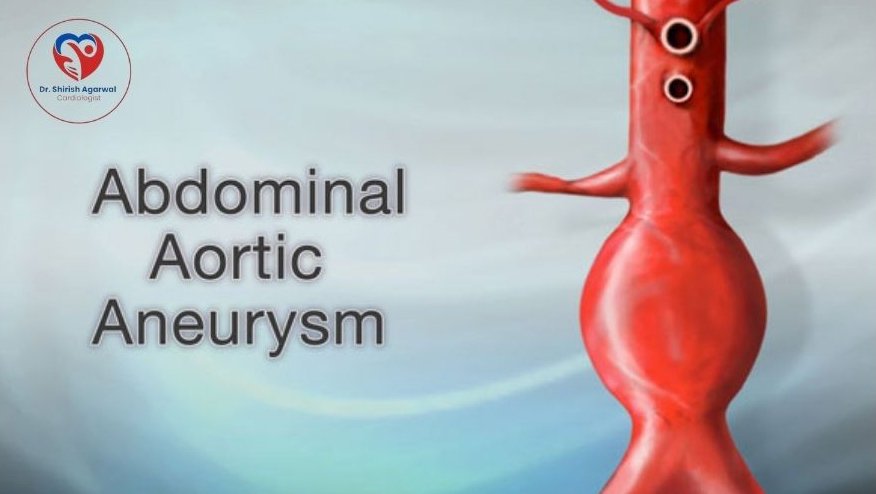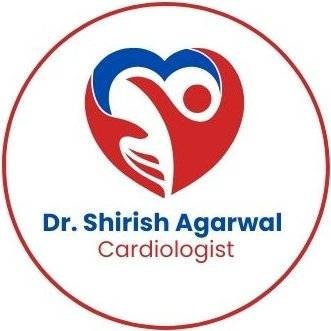Abdominal Aortic Aneurysm

An Abdominal Aortic Aneurysm (AAA) is an abnormal bulging of an artery in the abdominal area, caused by the weakening of the aortic wall. This condition typically arises from age-related factors such as hypertension, atherosclerosis, or trauma.
Dr. Shirish Agrawal, the best cardiologist in Indore, highlights the importance of awareness and early detection. Statistics indicate that one in every 25 people over the age of 65 has an AAA. If not treated promptly and effectively, an AAA can lead to life-threatening complications, including rupture, which results in severe internal bleeding. Even without rupture, individuals may be at risk for internal bleeding, stroke, or other severe side effects.
It is crucial to diagnose and treat AAA as early as possible to mitigate its prevalence and severity. Dr. Agrawal provides expert care in the diagnosis and management of AAAs, employing advanced techniques and personalized treatment plans to ensure optimal patient outcomes. Trust in Dr. Agrawal’s expertise to safeguard your cardiovascular health.
Symptoms of Abdominal Aortic Aneurysm (AAA)
Abdominal Aortic Aneurysm (AAA) can be difficult to detect, as it is often symptomless. However, individuals may have the following symptoms:
Pulsing Sensation
A noticeable pulsing in the abdomen or flank area.
Persistent Pain
Continuous abdominal or back pain.
Abdominal Fullness
A feeling of fullness in the abdomen.
Nausea
Episodes of nausea.
Fever
Occasional fever.
Vomiting
Incidents of vomiting.
Causes and Risk Factors of Abdominal Aortic Aneurysm (AAA)
Abdominal Aortic Aneurysm (AAA) can be caused by several factors, including:
Hypertension
High blood pressure can weaken the aortic wall, leading to an aneurysm.
Atherosclerosis
The buildup of plaque in the arteries can contribute to the development of AAA.
Trauma
Physical injury to the abdominal area can cause or exacerbate an aneurysm.
Age
AAA is more common in people over the age of 65.
Gender
Men have a higher risk of developing AAA than women
Smoking
Smoking is a significant risk factor that increases the likelihood of developing AAA.
High Blood Pressure
Persistent high blood pressure can increase the risk of AAA.
Family History
A family history of aneurysms or aortic disease elevates the risk.
Dr. Shirish Agrawal, the best cardiologist in Indore, emphasizes the importance of regular screenings for patients in these risk groups. Early detection through screenings can ensure timely and effective treatment, reducing the risk of severe complications associated with AAA.
Diagnosis of Abdominal Aortic Aneurysm (AAA)
If an Abdominal Aortic Aneurysm (AAA) is suspected, several imaging tests can be used to confirm the diagnosis:
Ultrasound
A non-invasive test that uses sound waves to create images of the aorta and detect any abnormalities.
CT Scan
A detailed imaging test that provides cross-sectional images of the aorta to identify the size and location of the aneurysm.
MRI
Magnetic resonance imaging offers detailed images of the aorta and surrounding structures to assess the aneurysm.
Further diagnostic procedures may include:
Angiography or Arteriogram: These tests involve injecting a contrast dye into the blood vessels to visualize the aorta and assess the size and location of the aneurysm.
Additionally, a blood pressure cuff test can help in diagnosing the condition.
Dr. Shirish Agrawal, the best cardiologist in Indore, recommends regular screenings for individuals in higher-risk groups to ensure early detection and timely treatment of AAA. These screenings are crucial for preventing severe complications and managing the condition effectively.
Treatment of Abdominal Aortic Aneurysm (AAA)
- Lifestyle Changes
- Quitting smoking
- Losing weight
- Controlling cholesterol levels
Surgical Treatments Abdominal Aortic Aneurysm (AAA)
Open Repair
- This involves making an incision in the abdomen to directly access and repair the aneurysm.
- Suitable for large or symptomatic aneurysms. Requires a longer recovery period but is effective for certain patients.
Endovascular Repair
- This minimally invasive procedure involves threading a catheter through the blood vessels to place a stent graft inside the aneurysm.
- Less invasive with a shorter recovery time.
- Suitable for patients with certain anatomical conditions.
Each procedure carries its own risks and benefits. Dr. Shirish Agrawal, the best cardiologist in Indore, will determine the most appropriate treatment based on the patient's medical history, age, and overall health condition. His expertise ensures that patients receive personalized and effective care tailored to their specific needs.
How Do Cardiologists Determine Which Treatment Is Appropriate?
Dr. Shirish Agrawal, the best cardiologist in Indore, determines the appropriate treatment for an Abdominal Aortic Aneurysm (AAA) based on several factors:
- Medical History: A thorough review of the patient’s past health issues.
- Age: Consideration of the patient’s age and associated risks. Overall Health Condition: Assessment of the patient’s general health and any underlying conditions. Aneurysm Size and Location: Evaluation of the aneurysm’s size (typically more than 5 cm for open repair) and precise location.
- Patient-Specific Information: Tailoring treatment based on individual circumstances.
Other considerations include the risk of recurrence and potential complications. Ultimately, Dr. Agrawal’s expertise ensures that the most suitable treatment option is chosen to meet each patient’s unique needs.
Recovery and Aftercare
Recovery and aftercare for Abdominal Aortic Aneurysm (AAA) treatment depend on the type of procedure and the patient’s condition:
Open Repair
Patients may need a hospital stay of up to two weeks post-surgery and might require additional therapy or rehabilitation.
Endovascular Repair
Typically does not require an extended hospital stay but follow-up appointments with Dr. Shirish Agrawal, the best cardiologist in Indore, is necessary.
Both treatments involve lifestyle changes such as quitting smoking, maintaining a healthy weight, and regular blood pressure and lipid screenings to ensure long-term health and prevent recurrence.
Abdominal Aortic Aneurysm (AAA) FAQs
An AAA is an abnormal bulging of the aorta in the abdomen, caused by the weakening of the aortic wall due to factors such as hypertension, atherosclerosis, or trauma. Dr. Shirish Agrawal, the best cardiologist in Indore, specializes in diagnosing and treating this condition.
AAA is often symptomless, but some patients may experience a pulsing sensation in the abdomen, persistent abdominal or back pain, a feeling of fullness in the abdomen, nausea, fever, or vomiting. Regular screenings are crucial for early detection, especially for those over
Common causes include hypertension, atherosclerosis, trauma, age-related factors, and smoking. Men and individuals with a family history of aneurysms are at higher risk. Dr. Shirish Agrawal can help manage these risk factors to prevent AAA development.
Imaging tests, such as ultrasound, CT scan, or MRI, are commonly used to diagnose. Additional procedures like angiography or an arteriogram may be used to assess the aneurysm’s size and location. Dr. Shirish Agrawal employs advanced diagnostic techniques to ensure accurate detection.
Treatment options include lifestyle changes (e.g., quitting smoking, losing weight), and surgical interventions such as open repair or endovascular repair. Dr. Shirish Agrawal will determine the most appropriate treatment based on the patient’s medical history, age, and overall health condition.
Recovery varies by treatment type. Open repair may require up to a two-week hospital stay and additional rehabilitation, while endovascular repair usually involves a shorter hospital stay with follow-up appointments. Both treatments require lifestyle changes and regular screenings to ensure long-term health, guided by Dr. Shirish Agrawal’s expertise.
